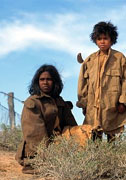
Movie Guru Rating:

Comment
on this review
| |

Rabbit-Proof Fence considers the evil of good intentions
by Jesse Fox Mayshark
Before I scare off anyone by talking about the politics of Phillip Noyce's fine Australian import, "Rabbit-Proof Fence," let me say that it's a rousing and engrossing adventure story. Among other things, it's a good family movie to see with kids over the age of 11 or 12, who will undoubtedly identify with the film's three heroines (aged 8 to 14). But you'd better be prepared for some serious talks afterward.
Rabbit-Proof Fence is one of two Noyce films making the rounds right now, the other being the Michael Caine vehicle "The Quiet American." While Caine's performance in that adaptation of Graham Greene's Vietnam novel snagged him an Oscar nomination, Rabbit-Proof Fence is the better of the two movies (not least because it's the one that doesn't co-star Brendan Fraser). But both are worth seeing. And in their own ways, both are about the terrible things that can happen in the name of enlightened civilization.
In Rabbit-Proof Fence the terrible things are the laws that, until a generation ago, strictly governed mixed-race marriages and offspring in Australia. Not only did unions between whites and Aborigines require state approval, but children of mixed heritage—"half-castes," in the government's primly racist terminology—were subject to removal from their homes and forcible separation from any trace of aboriginal culture. The goal, as outlined in the film by A.O. Neville (Kenneth Branagh), the state officer in charge of the program, was to capitalize on the children's white—and, obviously, superior—genes through several generations of forced breeding with other half-castes. By the fourth generation, Neville says, almost all of the "black" blood would have been bred out, leaving the descendants of the original child infinitely better off than if they were left to their own devices out in the bush.
Rabbit-Proof Fence is based on a true story written by the daughter of one of those children, the remarkable Molly Craig. Set in 1931, the movie opens with Molly, her younger sister Daisy, and her cousin Gracie living happily with their mothers and relatives in the Jigalog territory of the outback. Their fathers are white men who had come through the area years before, working on the cross-continental fence that gives the movie its name. (The fence plays an important role in the narrative, but it also serves as a sad metaphor. It was erected by the white government to control rampaging rabbits introduced to Australia by Europeans and promptly overran the country—just as whites themselves overran the land, with no fence to hold them back.)
Then, a police officer shows up one day, brandishing the race law, and pulls the three children from their mothers' arms. They are shipped to a camp full of half-caste girls, where they are forced to speak only English and taught reading, writing, and Christian religion by a group of nuns. Attempts to escape are punished with severe whippings.
It doesn't take the strong-willed Molly (Everlyn Sampi, a charismatic young actress) long to rebel. "Hate these stupid people," she mutters angrily, seeing their paternalism for the cultural genocide it is. And so one day, she takes her younger sister and cousin and flees into the woods, determined to find their way home. Most of the film concerns their 1,500-mile journey, traveling on foot for days and then weeks, relying on help from strangers and dodging police officers and a relentless aboriginal tracker (one of the film's many conflicted characters, he works for Neville's department because it's the only way Neville will let him see his mixed-blood daughter).
It is not a subtle film, and it sometimes overplays its hand. We don't need to know that Neville's favorite song is "Swanee River" to understand that the man is an old-school patrician racist. But Noyce is a good storyteller, and he's got a hell of a story to work with. The scenery helps too—the daunting prairie vistas provide a suitably mythic setting for the girls' odyssey.
The movie is inspiring in its details—in Molly's fierce self-assurance and improbable heroism—but it resists the Hollywood urge to make nice at the end. The film's last five minutes provide a coda that is among the most heartbreaking bits of cinema I've ever seen. Noyce doesn't want you to go home feeling good, he wants you to go home thinking.
He's no ideologue—Rabbit-Proof Fence is most condemnatory of the elitist liberal do-goodism that went hand in hand with cultural imperialism in the last century's eugenic campaigns. Although Neville is universally referred to as "Mr. Devil" by the aborigines, Branagh portrays him as a sincere social engineer—and all the more terrible for his bureaucratic blandness. Like Brendan Fraser's idealistic CIA agent in "The Quiet American," who thinks the benighted Vietnamese just need Uncle Sam to show them the way, Neville is dangerous because he's so sure of his own cultural and moral assumptions that he somehow rationalizes his way out of basic human decency. How can a government justify taking children away from loving parents? By being convinced it's for their own good. "If only these people could understand what we are trying to do for them," Neville says with a weary sigh. Now might be a good time to remember just how often that impulse has gone bad.

February 13, 2003 * Vol. 13, No. 7
© 2000 Metro Pulse
|